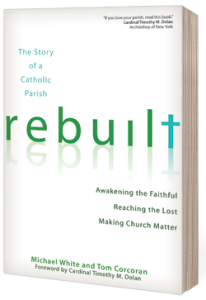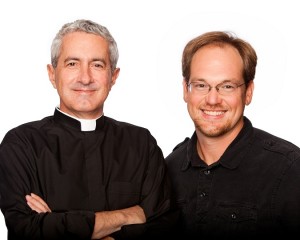 Michael White and Tom Corcoran, Rebuilt: The Story of a Catholic Parish: Awakening the Faithful, Reaching the Lost, Making Church Matter (Notre Dame, IN: Ave Maria Press, 2013). 280 pages plus notes (11 pp.). ISBN-13: 978-1-59471-386-6. $16.95.
Michael White and Tom Corcoran, Rebuilt: The Story of a Catholic Parish: Awakening the Faithful, Reaching the Lost, Making Church Matter (Notre Dame, IN: Ave Maria Press, 2013). 280 pages plus notes (11 pp.). ISBN-13: 978-1-59471-386-6. $16.95.
Review by Mark F. Fischer
Rebuilt is about the renewal of Nativity Church in Timonium, Maryland. When first-time pastor Father Michael White arrived in 1998 – “unenthusiastically, and without any intention of staying very long” (3-4) – he and pastoral associate Tom Corcoran found a church that was plagued by problems. The experience of Mass was “moribund and depressing.” The staff was “divided and deeply dysfunctional.” Preaching by guest celebrants was “uneven” and even “conflicting.” Volunteers had no sense of accountability and “were a law unto themselves” (pp. 5-6). As White discovered these problems, he said, he wanted to leave.
Then, in 2003, White and Corcoran attended a conference hosted by Rick Warren, pastor of Saddleback Church in California and the author of The Purpose Driven Church. After several visits, the two began to implement Warren’s key ideas: “Reach the lost and grow disciples through a focus on worship, fellowship, discipleship, service, and evangelization” (54). Although the two met resistance from parishioners and staff, they persevered. Rebuilt is a success story of how “the church almost tripled in weekend attendance from 1,400 to over 4,000” and of how “the commitment to the mission of the Church has grown” (299).
The first part of the book diagnoses the problems that White and Corcoran first encountered when White became pastor and hired Corcoran as youth minister. They described the spirit of the parish as a “consumer culture,” a culture that (at first) they shared. “The way we saw it, our parishioners were like customers, and we were here to serve them” (8). So the two ambitiously began to create programs: religious education, youth ministry, liturgical music, and Christian fellowship. Their efforts did not pay off in higher church attendance. “Consumer culture erodes the sustainability of church communities because it allows the congregant to assume the posture of shallow commitment and the attitude of ceaseless demands” (9-10). Instead of forming disciples, their efforts made parishioners more demanding and less committed.
After White and Corcoran visited Saddleback Church, they began to initiate changes. The second part of Rebuilt describes how they re-focused the parish’s mission on “reaching the lost.” The lost, say White and Corcoran, are those who “try to find a life outside a relationship with God,” whether they are “dechurched people who no longer go to church or unchurched people who never did” (40). Nativity’s new goal was to make the parish experience relevant and engaging for them. The two began with a Sunday evening Mass aimed at young people, challenging them to become disciples, even if that meant that they had to fundamentally change their lives.
Unfortunately, however, the parish itself resisted the changes. As White and Corcoran said, “What we did was make church all about who wasn’t there and [we] started challenging who was there to grow” (58). Long-time parishioners became “dissatisfied demanding consumers” who launched an attack. The pastor’s office was jokingly described as the “bunker” (61). Ushers resented having to give up their prime seats to meet the needs of parish newcomers. Eucharistic ministers resented the arrival of young people with tattoos and piercings. Parish musicians resented having to subordinate their personal preferences to the new direction (49-50). White and Corcoran had prophetically called for a transition at Nativity, but (as they acknowledge) they did not manage the transition well. They had rightly challenged parishioners to become evangelizers, but many parishioners interpreted the challenge as “unwelcoming” or even “threatening” (60).
The third part of Rebuilt (the last ten of fifteen chapters) describes the kinds of changes that White and Corcoran instituted in achieving their mission to “reach the lost and grow disciples.” They began to focus on the weekend liturgies where they would be able to touch the largest number of their target audience. Convinced that “churches will remain consumer-driven as long as people aren’t singing” (105), White and Corcoran initially made the mistake of offering a “menu of musical options” (97). They had a “choral” Mass, a “traditional” Mass with organ hymns, and a “contemporary” Mass. The menu approach, however, fostered consumerism, with congregants demanding liturgical music to their taste. Eventually, White and Corcoran decided that the music at all Masses should be virtually identical. It is mainly “praise and worship” music, akin to “adult alternative rock (with Christian lyrics),” supplemented by Gregorian chant during the acclamations of the Eucharistic prayer. Above everything else, the authors advise pastoral practitioners to choose music in view of the liturgy and to discuss this with parish musicians regularly.
Rick Warren emphasizes not only worship, but also fellowship, discipleship, service, and evangelization, and White and Corcoran follow suit. The authors narrate how they strengthened fellowship by establishing small groups (chapter 9). They built discipleship starting with religious education and youth ministry (chapter 7), and they called for tithing (chapter 10). They insisted that disciples perform Christian service (chapter 11) and they provided opportunities for mission (chapter 12). They evangelized, not just by welcoming the once-unwelcome, but by preaching a message designed to teach, delight, and move (chapter 8). All ten chapters of Part III conclude with a “You can do this!” section which contains practical steps that other parishes can take if they too want to be Rebuilt.
The renewal of Nativity Church is a gripping story that starts with the authors’ initial discouragement, proceeds to an inspiring encounter with Rick Warren and the clarification of the parish’s mission, and depicts a struggle with staff, volunteers and parishioners to achieve the mission of “reaching the lost and growing disciples.” White and Corcoran describe the evolution of their own understanding of parish life as they gradually applied the lessons they had learned at Saddleback. They transformed Nativity parish into a “purpose driven church” at considerable cost.
Rebuilt is riddled with anecdotes that reveal White and Corcoran’s anger at the staff they inherited, contempt for older volunteers, and dismissal of the parishioners who were reluctant to embrace the new vision. Again and again the authors vent their frustration at what they initially found at Nativity, making the reader wonder whether the transformation of the parish could have been achieved with less acrimony.
Consider, for instance, the characterization of the initial parish staff by White and Corcoran. “Gossip and lunch were the only tasks they lent themselves to with enthusiasm” (6). Later, White said that he made the mistake of “hiring too quickly . . . and firing too slowly.” Staff members included those “I didn’t really have any chemistry with (and vice-versa) or people who just didn’t fit our team” (21). The authors seem unaware of the principles of human resources management or progressive discipline. Most of the offending staff members apparently quit, rather than being fired. At one point we read, “Both secretaries just stormed off at different points (not sure why, guess they really didn’t like us after all)” (223). That is not surprising, given the authors’ anger at them.
The older parishioners and volunteers fared no better. White and Corcoran describe the cantors, lectors and Eucharistic ministers whom they initially found at Nativity in this way: “They had the job of sharing the spotlight with the celebrant and looking like the ultimate insiders” (7). If the authors had at first thought that “stalwart church-goers (senior citizens)” were their natural allies, they quickly abandoned that assumption. They hadn’t realized that older parishioners had a “deep sense of entitlement to whatever it was they were coming here to get” and “already represented the first generation of demanding consumers” (16). If senior citizens couldn’t understand the need for the transformation of the parish, it was their fault.
One of the duties of a pastor is to know his flock and to sympathize with them in their weakness. But as the authors began to encounter resistance to their reforms, they ceased to communicate with parishioners as they had earlier. “We stopped hosting town hall-style meetings, soliciting suggestions, or taking polls” (62). There is only one mention of a parish council meeting, characterized as an “unfriendly debate” (115). The authors show very little acquaintance with the principles of participative leadership. White remarks that “parish growth comes through attrition as well as addition” (63). He can only mean that, once the reluctant disciples were out of the way, the parish could grow as he wanted it to.
Rebuilt depicts a parish transformation (in the words of the book jacket) “drawing on the wisdom gleaned from thriving megachurches and innovative business leaders.” White and Corcoran committed themselves to making Christian disciples and they tripled the attendance at Nativity Church. Pastoral practitioners can learn, not just from their focused mission, but from their anger and contempt towards those who stood in their way.
To return to the book reviews, click here.

